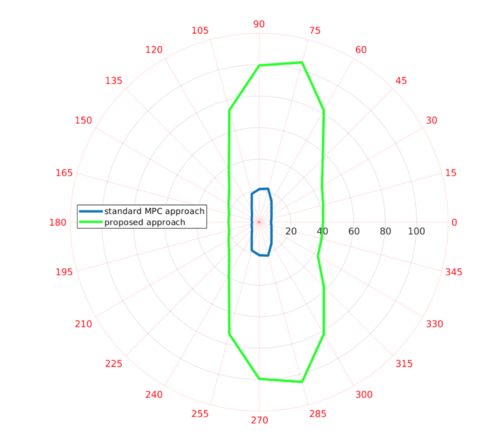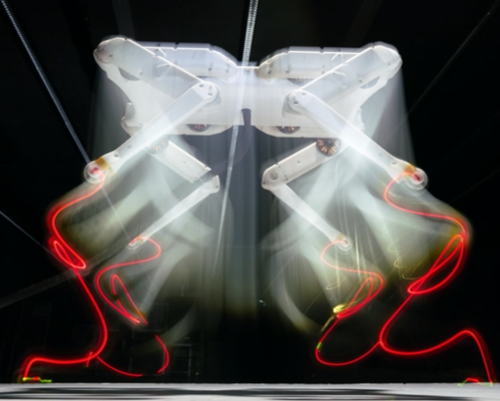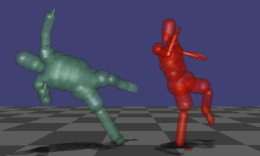2023
Meduri, A., Shah, P., Viereck, J., Khadiv, M., Havoutis, I., Righetti, L.
BiConMP: A Nonlinear Model Predictive Control Framework for Whole Body Motion Planning
IEEE Transactions on Robotics, 39(2):905-922, IEEE, 2023 (article)
2022
Bogdanovic, M., Khadiv, M., Righetti, L.
Model-free reinforcement learning for robust locomotion using demonstrations from trajectory optimization
Frontiers in Robotics and AI, 9, August 2022 (article)
Jordana, A., Hammoud, B., Carpentier, J., Righetti, L.
Stagewise Newton Method for Dynamic Game Control With Imperfect State Observation
IEEE Control Systems Letters, 6, pages: 3241-3246, IEEE, Piscataway, NJ, USA, 2022 (article)
2021
Yeganegi, M. H., Khadiv, M., Prete, A. D., Moosavian, S. A. A., Righetti, L.
Robust walking based on MPC with viability guarantees
IEEE Transactions on Robotics, October 2021 (article) Accepted
Berenz, V., Naveau, M., Widmaier, F., Wüthrich, M., Passy, J., Guist, S., Büchler, D.
The o80 C++ templated toolbox: Designing customized Python APIs for synchronizing realtime processes
Journal of Open Source Software, 6(66), October 2021 (article)
Hammoud, B., Khadiv, M., Righetti, L.
Impedance Optimization for Uncertain Contact Interactions Through Risk Sensitive Optimal Control
IEEE Robotics and Automation Letters, Robotics and Automation Letters, 6(3):4766-4773, IEEE, July 2021 (article)
Daneshmand, E., Khadiv, M., Grimminger, F., Righetti, L.
Variable Horizon MPC with Swing Foot Dynamics for Bipedal Walking Control
IEEE Robotics and Automation Letters, 6(2):2349-2356, April 2021 (article)
Ponton, B., Khadiv, M., Meduri, A., Righetti, L.
Efficient Multi-Contact Pattern Generation with Sequential Convex Approximations of the Centroidal Dynamics
IEEE Transactions on Robotics, 37(5):1661-1679, IEEE, February 2021 (article)
Marco, A., Baumann, D., Khadiv, M., Hennig, P., Righetti, L., Trimpe, S.
Robot Learning with Crash Constraints
IEEE Robotics and Automation Letters, 6(2):1439-1446, IEEE, February 2021 (article)
Flayols, T., Prete, A. D., Khadiv, M., Mansard, N., Righetti, L.
Reactive Balance Control for Legged Robots under Visco-Elastic Contacts
Applied Sciences, 11(1), MDPI, 2021 (article)
Gazar, A., Nava, G., Chavez, F. J. A., Pucci, D.
Jerk Control of Floating Base Systems With Contact-Stable Parameterized Force Feedback
IEEE Transactions on Robotics, 37(1):1-15, IEEE, 2021 (article)
2020
Choi, H., Crump, C., Duriez, C., Elmquist, A., Hager, G., Han, D., Hearl, F., Hodgins, J., Jain, A., Leve, F., Li, C., Meier, F., Negrut, D., Righetti, L., Rodriguez, A., Tan, J., Trinkle, J.
On the use of simulation in robotics: Opportunities challenges, and suggestions for moving forward
PNAS, 118(1), December 2020 (article)
Bogdanovic, M., Khadiv, M., Righetti, L.
Learning Variable Impedance Control for Contact Sensitive Tasks
IEEE Robotics and Automation Letters, 5(4), IEEE, October 2020 (article)
Khadiv, M., Herzog, A., Moosavian, S. A. A., Righetti, L.
Walking Control Based on Step Timing Adaptation
IEEE Transactions on Robotics, 36(3):629-643, IEEE, June 2020 (article)
Grimminger, F., Meduri, A., Khadiv, M., Viereck, J., Wüthrich, M., Naveau, M., Berenz, V., Heim, S., Widmaier, F., Flayols, T., Fiene, J., Badri-Spröwitz, A., Righetti, L.
An Open Torque-Controlled Modular Robot Architecture for Legged Locomotion Research
IEEE Robotics and Automation Letters, 5(2):3650-3657, IEEE, April 2020 (article)
Lin, Y., Righetti, L., Berenson, D.
Robust Humanoid Contact Planning with Learned Zero-and One-Step Capturability Prediction
IEEE Robotics and Automation Letters, Robotics and Automation Letters, 5, pages: 2451-2458, IEEE, February 2020 (article)
2019
Bretl, T., Righetti, L., Madhavan, R.
Epstein, Project Maven, and Some Reasons to Think About Where We Get Our Funding [Ethical, Legal, and Societal Issues]
IEEE Robotics & Automation Magazine, 26, December 2019 (article)
Righetti, L., Madhavan, R., Chatila, R.
Unintended Consequences of Biased Robotic and Artificial Intelligence Systems [Ethical, Legal, and Societal Issues]
IEEE Robotics & Automation Magazine, 26, September 2019 (article)
Shahrokhshahi, A., Yousefi-Koma, A., Khadiv, M., Mansouri, S., Mohtasebi, S. S.
Optimal Stair Climbing Pattern Generation for Humanoids Using Virtual Slope and Distributed Mass Model
Journal of Intelligent and Robotics Systems, 94:1, pages: 43-59, April 2019 (article)
Rebula, J. R., Schaal, S., Finley, J., Righetti, L.
A Robustness Analysis of Inverse Optimal Control of Bipedal Walking
IEEE Robotics and Automation Letters, 4(4):4531-4538, 2019 (article)
Khadiv, M., Moosavian, S. A. A., Yousefi-Koma, A., Sadedel, M., Ehsani-Seresht, A., Mansouri, S.
Rigid vs compliant contact: an experimental study on biped walking
Multibody System Dynamics, 45(4):379-401, 2019 (article)
Schmidt, P., Blessing, M., Rageot, M., Iovita, R., Pfleging, J., Nickel, K. G., Righetti, L., Tennie, C.
Birch tar production does not prove Neanderthal behavioral complexity
Proceedings of the National Academy of Sciences (PNAS), 116(36):17707-17711, 2019 (article)
2018
Borno, M. A., Righetti, L., Black, M. J., Delp, S. L., Fiume, E., Romero, J.
Robust Physics-based Motion Retargeting with Realistic Body Shapes
Computer Graphics Forum, 37, pages: 6:1-12, July 2018 (article)
Viereck, J., Kozolinsky, J., Herzog, A., Righetti, L.
Learning a Structured Neural Network Policy for a Hopping Task.
IEEE Robotics and Automation Letters, 3(4):4092-4099, October 2018 (article)
Pham, Q., Madhavan, R., Righetti, L., Smart, W., Chatila, R.
The Impact of Robotics and Automation on Working Conditions and Employment [Ethical, Legal, and Societal Issues]
IEEE Robotics and Automation Magazine, 25(2):126-128, June 2018 (article)
Righetti, L., Pham, Q., Madhavan, R., Chatila, R.
Lethal Autonomous Weapon Systems [Ethical, Legal, and Societal Issues]
IEEE Robotics \& Automation Magazine, 25(1):123-126, March 2018 (article)
2016
Herzog, A., Rotella, N., Mason, S., Grimminger, F., Schaal, S., Righetti, L.
Momentum Control with Hierarchical Inverse Dynamics on a Torque-Controlled Humanoid
Autonomous Robots, 40(3):473-491, 2016 (article)
2015
Righetti, L., Nylen, A., Rosander, K., Ijspeert, A.
Kinematic and gait similarities between crawling human infants and other quadruped mammals
Frontiers in Neurology, 6(17), February 2015 (article)
2014
Righetti, L., Kalakrishnan, M., Pastor, P., Binney, J., Kelly, J., Voorhies, R. C., Sukhatme, G. S., Schaal, S.
An autonomous manipulation system based on force control and optimization
Autonomous Robots, 36(1-2):11-30, January 2014 (article)
Herzog, A., Pastor, P., Kalakrishnan, M., Righetti, L., Bohg, J., Asfour, T., Schaal, S.
Learning of grasp selection based on shape-templates
Autonomous Robots, 36(1-2):51-65, January 2014 (article)
2013
Righetti, L., Buchli, J., Mistry, M., Kalakrishnan, M., Schaal, S.
Optimal distribution of contact forces with inverse-dynamics control
The International Journal of Robotics Research, 32(3):280-298, March 2013 (article)
Gregg, R., Righetti, L.
Controlled Reduction with Unactuated Cyclic Variables: Application to 3D Bipedal Walking with Passive Yaw Rotation
IEEE Transactions on Automatic Control, 58(10):2679-2685, October 2013 (article)
2011
Degallier, S., Righetti, L., Gay, S., Ijspeert, A.
Toward simple control for complex, autonomous robotic applications: combining discrete and rhythmic motor primitives
Autonomous Robots, 31(2-3):155-181, October 2011 (article)
2009
Righetti, L., Buchli, J., Ijspeert, A.
Adaptive Frequency Oscillators and Applications
The Open Cybernetics \& Systemics Journal, 3, pages: 64-69, 2009 (article)
2008
Buchli, J., Righetti, L., Ijspeert, A.
Frequency analysis with coupled nonlinear oscillators
Physica D: Nonlinear Phenomena, 237(13):1705-1718, August 2008 (article)
2007
Tsagarakis, N., Metta, G., Sandini, G., Vernon, D., Beira, R., Becchi, F., Righetti, L., Santos-Victor, J., Ijspeert, A., Carrozza, M., Caldwell, D.
iCub - The Design and Realization of an Open Humanoid Platform for Cognitive and Neuroscience Research
Advanced Robotics, 21(10):1151-1175, 2007 (article)
2006
Righetti, L., Buchli, J., Ijspeert, A.
Dynamic Hebbian learning in adaptive frequency oscillators
Physica D: Nonlinear Phenomena, 216(2):269-281, 2006 (article)
Buchli, J., Righetti, L., Ijspeert, A.
Engineering Entrainment and Adaptation in Limit Cycle Systems – From biological inspiration to applications in robotics
Biological Cybernetics, 95(6):645-664, December 2006 (article)






